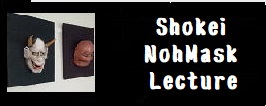| Shokei's philosophy
Shokei hopes to
create Noh masks that exudes human drama, like Katsushika Hokusai's works.
In the 1998 issue of the American magazine LIFE, Katsushika Hokusai was
the only Japanese person to be selected as one of the "100 people
who
have made great achievements in the last 1000 years."
Why was the
value of Katsushika Hokusai's work recognized by so many artists, including Van
Gogh, Picasso, and Debussy, after his death?
Shokei thinks
the reason is as follows: Hokusai's paintings are imbued with his philosophy
and way of life, and his paintings convey the living environment and human
drama of at the time to many viewers.
On the other
hand, Noh was perfected by father Kan'ami and the son Zeami in the 14th
century, and their Noh plays portray dramas of human joy, anger, sorrow, and
happiness, bringing tears and laughter to many viewers. The reason why Noh is
still loved even now, hundreds of years after the deaths of Kan'ami and Zeami,
is probably because it gives the same emotions to people in the modern age.
Noh masks are essential when performing Noh on stage, and the drama of
Noh is condensed in the facial expression. A Noh mask must remind viewers
of human drama. Shokei devotes himself to making Noh masks every day for
about 40 years, with the earnest desire to create masks that evoke the
dramas that appear in Japanese classical literature such as the Tale of
Genji and the Tales of Ise. Shokei hopes that you will be able to feel
Shokei's philosophy on Noh masks through some of his works in this exhibition
of in Los Angels on Aug.17-18,2024.
|
 Updated on Aug.1, 2025, since 2020
Updated on Aug.1, 2025, since 2020 "Big SAle for Nisei-Week."
"Big SAle for Nisei-Week."





